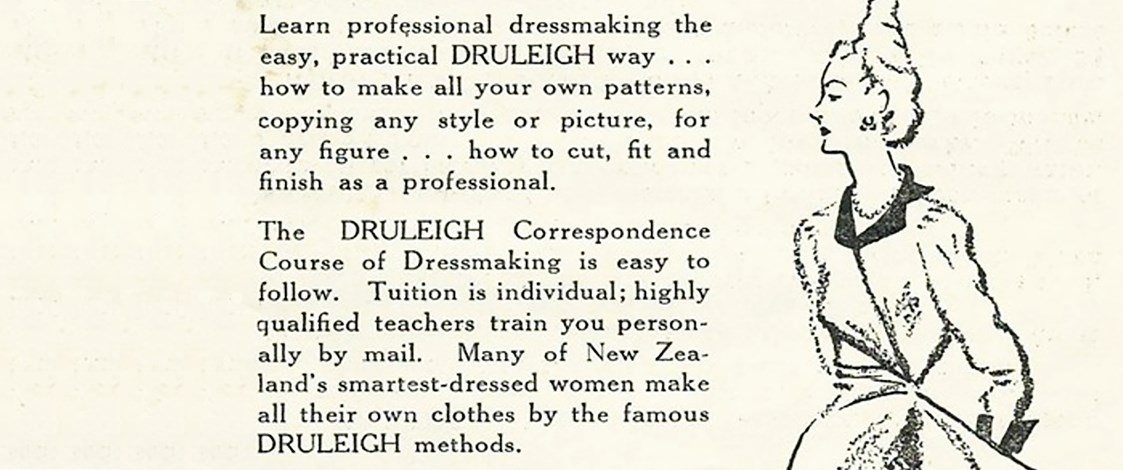Stories
Druleigh College of Dressmaking
1927-1950s

Druleigh College made a lasting impact on New Zealand society, training thousands of graduates for a professional career. Many Druleigh graduates went on to work for fashion manufacturers such as El Jay and Reslau Frocks. Later, as married women with families, they could use their skills to supplement their incomes through dressmaking.
Already established in Australia, the Druleigh Business and Technical College NZ Ltd opened in Auckland in 1927. The seven shareholders sought to establish a business and training college that provided both onsite and correspondence education.

Druleigh College opened in New Zealand in 1927.
The college was located on the 5th floor of the Tasman Buildings in Anzac Avenue, and training was offered in subjects including typewriting, book-keeping, pharmacy, conversational French, German and Italian, dressmaking, millinery and civil, mechanical and electrical engineering. Daytime and evening classes were available. They promoted low fees; an advertisement from 1940 read: "For the price of one frock you can have a term of 20 lessons at Druleigh" (New Zealand Herald, 9 May 1940).

A Druleigh College advertisement from 1940.
The Druleigh College motto was 'Good enough is not enough', a sentiment echoed in several decades of newspaper advertisements for Druleigh. Slogans included: 'Learn more, earn more', 'Prepare for promotion. Druleigh students are always prepared', 'Work is the only road to success', 'You must have ambition if you want to succeed' and 'Druleigh: The college of successful careers'.
Druleigh College was known for its dressmaking courses and advertisements promoted Druleigh as 'New Zealand’s premier dressmaking school'. In the late 1930s the college moved to Vulcan Lane - a part of the city that was in the centre of a thriving garment industry.
The Druleigh Book of Dressmaking included practical instructions for students.
Additional campuses focused on dressmaking opened across the North Island in the 1940s. In Hamilton, Druleigh College was located in the Wesley Chambers; students could also attend dressmaking classes at their premises in Wellington’s Colonial Mutual Buildings and in Palmerston North and Lower Hutt.
A free dressmaking demonstration marked the opening of the Druleigh College of Dressmaking School in Wellington in 1941. An Evening Post advertisement promoted the event. "Druleigh teachers will explain the dressmaking course and give a demonstration of how to design clothes, cut patterns, etc. Don't miss this interesting display." (24 January 1941).
Students graduated with a Diploma in Dressmaking and Pattern Cutting.

Valerie Harris achieved her diploma in dressmaking and pattern cutting at Druleigh College in 1949.
Barbara Herrick attended Druleigh College in the late 1940s. For two years she travelled by tram from her home in Mt Roskill to the Vulcan Lane campus. Dressmaking classes were located on the top floor; typing classes on the ground floor. The students shared a cloakroom.
Classes started every morning at 8:30am. There were two teachers and a number of assistants to support the students who were at varying stages of the course. Barbara recalls they had learn basic pattern making and cutting before they were allowed near a sewing machine. World War Two rationing was still in place for some items, and the lack of some materials meant that there were many adaptations. The shortage of elastic required 'scanties' to be done up with buttons and students were taught to cut fabric without waste.
Not all sewing projects were welcomed. Bloomers were particularly unpopular and Barbara disliked learning to make diamond gussets and oval gussets. She was grateful she had acquired the expertise however when in the 1960s when the fashionable maygar sleeve required the insertion of gussets to allow for arm movement.
After two years Barbara passed her final sewing test and received her graduation certificate.
Druleigh College closed in the late 1950s.
Text by Kelly Dix. Banner image circa 1936, no known copyright.
Last published February 2017.